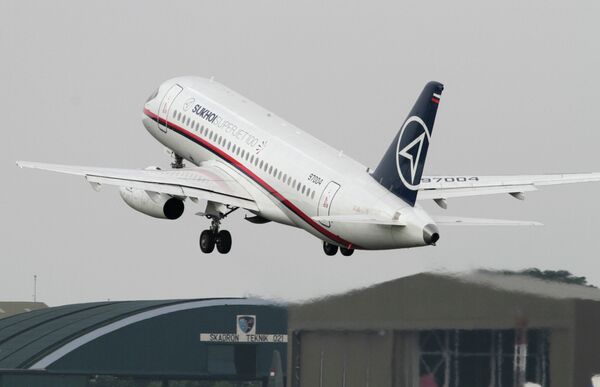BALI (Indonesia), March 5 (RIA Novosti) - Indonesia’s Kartika Airlines, which signed a $900 million contract in 2010 for the delivery of 30 Sukhoi Superjet-100 airliners with Russia’s Sukhoi Civil Aircraft Company, denied that the deal was off on Tuesday.
“We are continuing negotiations with Sukhoi Civil Aircraft Company and are not abandoning our plans to buy [SSJ-100s],” company CEO Kim J. Mulia told RIA Novosti, commenting on Monday’s statement by Mikhail Pogosyan, president of the United Aircraft Corporation that unites all Russian aircraft manufacturing assets, that its Indonesian partner had run into problems.
Pogosyan also said the contract has not gone through the required approval processes and was thus being delayed.
“Our plans have not gone as we had hoped when we were signing the contract,” he told the Vedomosti daily.
According to some media reports, Kartika has filed for bankruptcy and its operating license was suspended by the Indonesian Transport Ministry months ago.
At the moment, Kartika Airlines is only operating three planes, said Roman Gusarov, editor in chief of the Avia.ru aviation news website. In 2012, the airline was banned from flying to the European Union. Gusarov said the Superjet-100 contract would have increased Kartika’s fleet ten times over.
Sky Aviation, another Indonesian airline that plans to buy 12 SSJ-100s, received its first plane last week.
Last November, Indonesia’s Civil Aviation Authority issued an airworthiness certificate to Sukhoi Superjet-100, allowing the jet’s export to Indonesia and its operation by the country’s airlines without restrictions.
Last May, a SSJ-100 crashed into a mountain south of Jakarta while performing a demonstration flight in Indonesia with 45 people onboard, eight of whom were Russians, including crew members and Sukhoi employees. There were no survivors.
The RRJ (Russian Regional Jet) project to develop the Sukhoi Superjet 100 airliner (available in two models: regular and extended range, both with 75 or 95 passenger seats), was launched in the early 2000s.
The project was on and off until the first flight took place in May 2008, and deliveries to customers began in 2011. The airliner is manufactured at the main Sukhoi factory in Komsomolsk-on-Amur and is positioned as a new Russian design.
The Russian origin of the aircraft, however, is questionable. In fact, construction materials, fuselage elements and a set of auxiliary equipment are the only Russian elements in it. French SaM-146 engines were also jointly designed with the Saturn research-and-production association. Almost everything else is foreign-made, including avionics, the electrical system, control systems and even the auxiliary power unit.
Sukhoi developed the Superjet 100 in cooperation with US and European aviation corporations, including Boeing, Snecma, Thales, Messier Dowty, Liebherr Aerospace and Honeywell.


